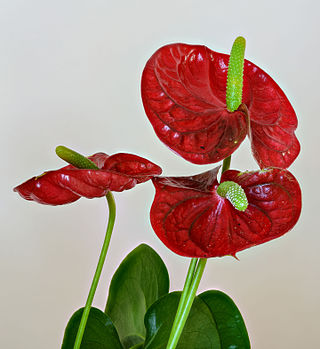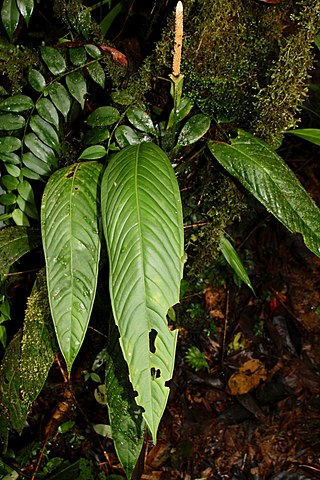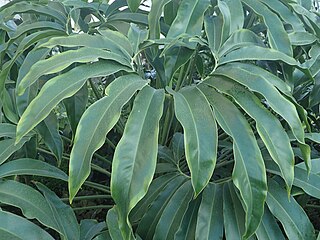Related Research Articles

The Araceae are a family of monocotyledonous flowering plants in which flowers are borne on a type of inflorescence called a spadix. The spadix is usually accompanied by, and sometimes partially enclosed in, a spathe. Also known as the arum family, members are often colloquially known as aroids. This family of 114 genera and about 3,750 known species is most diverse in the New World tropics, although also distributed in the Old World tropics and northern temperate regions.

The Mimosoideae are a traditional subfamily of trees, herbs, lianas, and shrubs in the pea family (Fabaceae) that mostly grow in tropical and subtropical climates. They are typically characterized by having radially symmetric flowers, with petals that are twice divided (valvate) in bud and with numerous showy, prominent stamens.

Xanthosoma is a genus of flowering plants in the arum family, Araceae. The genus is native to tropical America but widely cultivated and naturalized in other tropical regions. Several are grown for their starchy corms, an important food staple of tropical regions, known variously as malanga, otoy, otoe, cocoyam, tannia, tannier, yautía, macabo, ocumo, macal, taioba, dasheen, quequisque, ʻape and as Singapore taro. Many other species, including especially Xanthosoma roseum, are used as ornamental plants; in popular horticultural literature these species may be known as ‘ape due to resemblance to the true Polynesian ʻape, Alocasia macrorrhizos, or as elephant ear from visual resemblance of the leaf to an elephant's ear. Sometimes the latter name is also applied to members in the closely related genera Caladium, Colocasia (taro), and Alocasia.

Abarema is a neotropical genus in the family Fabaceae. It is native to Brazil, Cuba, and Venezuela. Most of the species can be found in the Amazon Basin and the Guyana Highlands. They have a deep-green fernlike foliage, with bipinnately compound leaves.

Anthurium is a genus of about 1,000 species of flowering plants, the largest genus of the arum family, Araceae. General common names include anthurium, tailflower, flamingo flower, pigtail plant, and laceleaf.

Spathiphyllum is a genus of about 60 species of monocotyledonous flowering plants in the family Araceae, native to tropical regions of the Americas and southeastern Asia. Certain species of Spathiphyllum are commonly known as spath or peace lilies.

Dracontium is a genus of flowering plants similar to those of Amorphophallus. Unlike Amorphophallus which is found in the Old World, this genus has a New World distribution and is native to South America, Central America, southern Mexico, and the West Indies.

Sauromatum venosum is a species of plant in the arum family, Araceae. It is native to Asia and Africa, where it grows in forests and riparian meadows.
Pseudalbizzia buntingii is a species of plant in the family Fabaceae. It a tree found only in Zulia state of Venezuela.

Holochlamys is a monotypic genus of flowering plants in the family Araceae. Holochlamys beccarii is the only species in the genus Holochlamys. It is native to New Guinea and the Bismarck Archipelago and is found growing in mud near lowland streams or rocky streambeds at high elevations.

Urospatha is a genus of flowering plants in the family Araceae that consists of 11 known species. They are found growing in South America and Central America in swamps, wet savannahs, and brackish water. The leaves of the species in this genus are upward pointing and sagittate (arrow-shaped). The inflorescences are quite unique; the spathe is mottled and elongated with a spiral twist at the end. The seeds are distributed by water and have a texture similar to cork that allows them to float. They also quickly germinate in water.
Hiroyoshi Ohashi is a botanist formerly at the University of Tokyo and Tohoku University. He began publishing on Japanese Arisaema in the early 1960s. He published a couple of miscellaneous notes on Arisaema in 1963 and 1964 and these were followed by a revision of the genus for Japan jointly published in 1980 with J. Murata, and by the Araceae treatment for the Wildflowers of Japan.

Dr. Charlotte M. Taylor is a botanist and professor specialising in taxonomy and conservation. She works with the large plant family Rubiaceae, particularly found in the American tropics and in the tribes Palicoureeae and Psychotrieae. This plant family is an economically important group, as it includes plant species used to make coffee and quinine. Taylor also conducts work related to the floristics of Rubiaceae and morphological radiations of the group. Taylor has collected plant samples from many countries across the globe, including Chile, Colombia, Costa Rica, Panama, and the United States of America, and has named many new species known to science from these regions. As of 2023, Taylor has authored 500 land plant species' names, the third-highest number of such names authored by any female scientist.
Thomas Bernard Croat is an American botanist and plant collector, noteworthy as one of botanical history's "most prolific plant collectors". He has collected and described numerous species of plants, particularly in the family Araceae, in his career at the Missouri Botanical Garden.
James Walter Grimes, known as Jim Grimes, is an American botanist.
Ulearum donburnsii is a species of plant in the family Araceae. Native to the Amazonian lowlands of Ecuador, it can be distinguished from its relative Ulearum sagittatum by the finer, thread-like staminodes on its spadix. It has arrowhead-shaped leaves and grows terrestrially from small rhizomes. The species was described in 2003 and named for Don Burns, a noted grower of aroids and a member of the International Aroid Society.

Anthurium microspadix is a species of plant in the genus Anthurium. Growing as an epiphyte or a terrestrial shrub, it is native from the southern Mexican states of Oaxaca and Chiapas to Bolivia from 800–2,300 metres (2,600–7,500 ft) in elevation. One of the more widely distributed and variable species in its genus, it is easily confused with species such as Anthurium pallens and others.

Anthurium pallens is a species of plant in the genus Anthurium. Growing as a climbing epiphyte with short stems and usually pendent growth, it is native to Central America. Easily confused with other species such as Anthurium microspadix, it can be distinguished by its typically shorter branches and leaf blades acute to rounded at the base.

Thaumatophyllum spruceanum is a neotropical hemiepiphytic or scrambling plant in the genus Thaumatophyllum, in the family Araceae. It is native to northern South America.
References
- ↑ "Bunting, George Sydney (1927-2015) on JSTOR". plants.jstor.org. Retrieved 2024-10-22.
- ↑ "Harvard University Herbaria & Libraries". kiki.huh.harvard.edu. Retrieved 2024-10-22.
- ↑ Croat, Thomas; Lambert, Nancy (1986). "The Araceae of Venezuela" (PDF). Aroideana. 9.
- ↑ Croat, Thomas (1998). "History and Current Status of Systematic Research With Araceae" (PDF). Aroideana. 21.
- ↑ International Plant Names Index. G.S.Bunting.
- ↑ Taxon. Rev. Pentandr. Arist. 45 1970 (IK)
- ↑ Novon 7(1): 44. 1997 (IK)
- ↑ Mem. New York Bot. Gard. 74(1): 223. 1996 ; Barneby & Grimes, Silk Tree, Guanacaste, Monkey's Earring (IK)
- ↑ Fl. Neotrop. Monogr. 1: 204 1968 (IK)
- ↑ Contr. Univ. Michigan Herb. 21: 63 1997 (IK)
- ↑ Ann. Missouri Bot. Gard. 74(2): 399 1987 (IK)